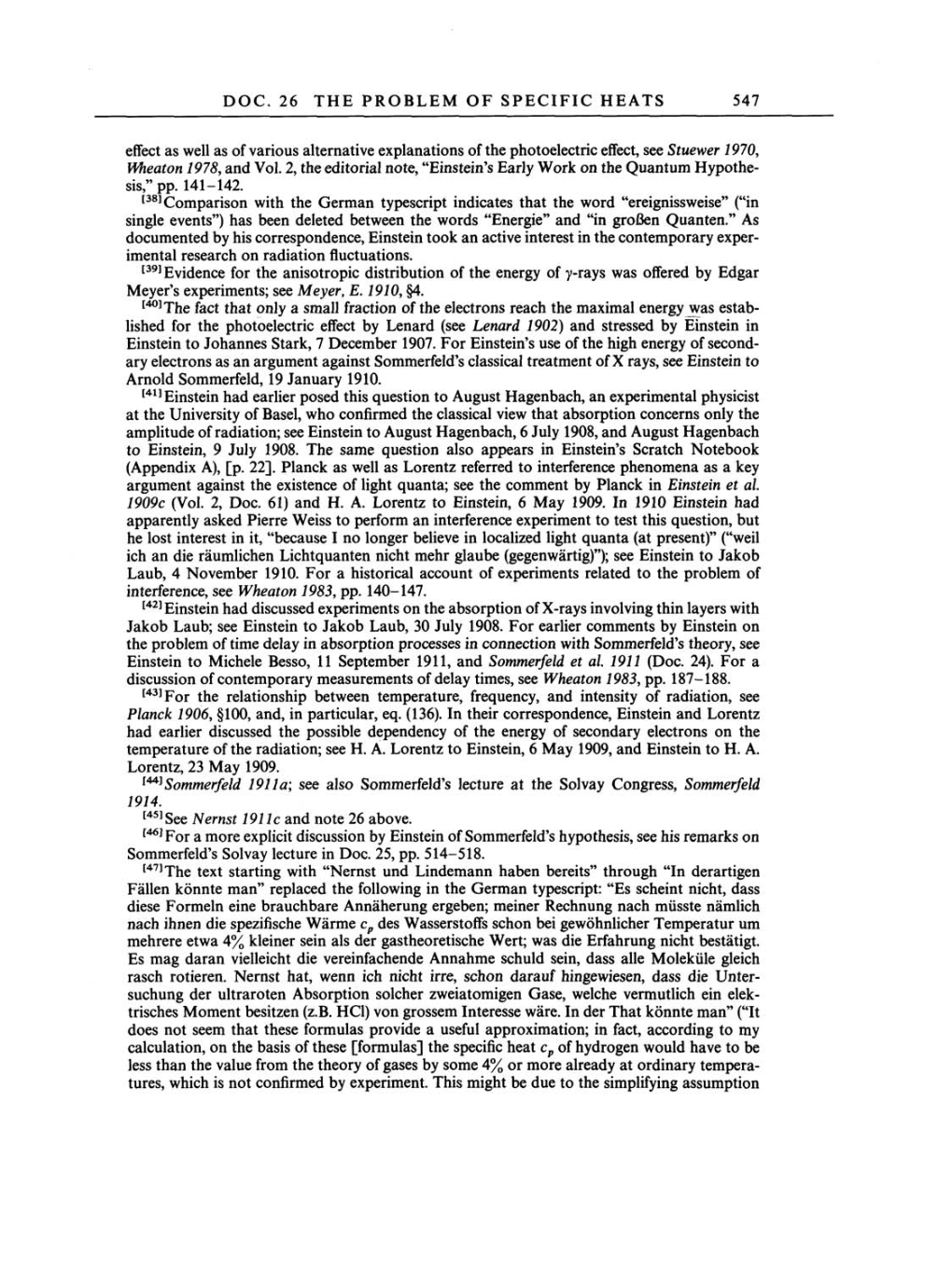DOC.
26 THE
PROBLEM
OF
SPECIFIC HEATS
547
effect
as
well
as
of various alternative
explanations
of the
photoelectric effect, see
Stuewer
1970,
Wheaton
1978,
and
Vol.
2,
the editorial
note,
"Einstein's
Early
Work
on
the
Quantum Hypothe-
sis,"
pp.
141-142.
[38]Comparison
with
the
German
typescript
indicates
that the word
"ereignissweise"
("in
single
events")
has been
deleted between
the
words
"Energie"
and "in
großen Quanten."
As
documented
by
his
correspondence,
Einstein took
an
active interest
in
the
contemporary exper-
imental
research
on
radiation fluctuations.
[39]Evidence for the
anisotropic
distribution of the
energy
of
y-rays
was
offered
by
Edgar
Meyer's experiments;
see
Meyer,
E.
1910,
§4.
[40]The fact
that
only
a
small fraction of the electrons reach the maximal
energy was
estab-
lished
for the
photoelectric
effect
by
Lenard
(see
Lenard
1902)
and stressed
by
Einstein
in
Einstein
to
Johannes
Stark,
7
December
1907.
For
Einstein's
use
of
the
high energy
of second-
ary
electrons
as
an
argument against
Sommerfeld's
classical
treatment
of
X
rays, see
Einstein
to
Arnold
Sommerfeld,
19
January 1910.
[41] Einstein had earlier
posed
this
question to August Hagenbach,
an
experimental physicist
at
the
University
of
Basel,
who confirmed the
classical view
that
absorption
concerns only
the
amplitude
of
radiation;
see
Einstein
to August Hagenbach, 6 July
1908,
and
August Hagenbach
to
Einstein,
9
July 1908.
The
same
question
also
appears
in Einstein's Scratch Notebook
(Appendix
A),
[p. 22].
Planck
as
well
as
Lorentz
referred to
interference
phenomena
as a
key
argument against
the existence of
light quanta;
see
the
comment
by
Planck in Einstein et al.
1909c
(Vol.
2,
Doc.
61)
and
H. A.
Lorentz
to Einstein,
6
May 1909.
In
1910
Einstein had
apparently
asked Pierre
Weiss to perform
an
interference
experiment
to test
this
question,
but
he
lost interest
in
it,
"because
I
no
longer
believe in
localized
light quanta (at present)"
("weil
ich
an
die
räumlichen
Lichtquanten
nicht mehr
glaube
(gegenwärtig)"); see
Einstein to Jakob
Laub, 4
November
1910.
For
a
historical
account
of
experiments
related to the
problem
of
interference,
see
Wheaton
1983,
pp.
140-147.
[42]Einstein
had discussed
experiments
on
the
absorption
of
X-rays
involving
thin
layers
with
Jakob
Laub;
see
Einstein
to
Jakob
Laub, 30 July 1908.
For earlier
comments
by
Einstein
on
the
problem
of
time delay
in
absorption processes
in
connection
with
Sommerfeld's
theory,
see
Einstein
to
Michele
Besso,
11
September
1911,
and
Sommerfeld
et al. 1911
(Doc.
24).
For
a
discussion of
contemporary
measurements
of
delay
times,
see
Wheaton
1983,
pp.
187-188.
[43]For
the
relationship
between
temperature, frequency,
and
intensity
of
radiation, see
Planck
1906, §100,
and,
in
particular,
eq. (136).
In their
correspondence,
Einstein and Lorentz
had earlier discussed the
possible dependency
of the
energy
of
secondary
electrons
on
the
temperature
of the
radiation;
see
H.
A.
Lorentz
to Einstein, 6
May 1909,
and Einstein
to H.
A.
Lorentz,
23
May
1909.
[44]Sommerfeld
1911a;
see
also Sommerfeld's lecture
at
the
Solvay
Congress,
Sommerfeld
1914.
[45]See
Nernst
1911c
and
note 26
above.
[46]For
a
more explicit
discussion
by
Einstein of Sommerfeld's
hypothesis, see
his
remarks
on
Sommerfeld's
Solvay
lecture in Doc.
25, pp.
514-518.
[47]The text starting
with "Nernst und Lindemann haben bereits"
through
"In
derartigen
Fällen könnte
man"
replaced
the
following
in
the German
typescript:
"Es scheint
nicht,
dass
diese
Formeln
eine
brauchbare
Annäherung ergeben;
meiner
Rechnung
nach müsste nämlich
nach ihnen die
spezifische
Wärme
cp
des
Wasserstoffs schon
bei
gewöhnlicher Temperatur um
mehrere
etwa
4%
kleiner
sein als
der
gastheoretische
Wert;
was
die
Erfahrung
nicht
bestätigt.
Es
mag
daran vielleicht die vereinfachende Annahme schuld
sein,
dass
alle
Moleküle
gleich
rasch rotieren. Nernst
hat,
wenn
ich
nicht
irre,
schon darauf
hingewiesen,
dass die Unter-
suchung
der ultraroten
Absorption
solcher
zweiatomigen
Gase, welche
vermutlich
ein elek-
trisches Moment besitzen
(z.B.
HCl)
von
grossem
Interesse
wäre.
In der That könnte man"
("It
does
not seem
that
these formulas
provide
a
useful
approximation;
in
fact,
according
to
my
calculation, on
the basis of
these
[formulas]
the
specific
heat
cp
of
hydrogen
would have
to
be
less
than the value from the
theory
of
gases by
some
4% or
more already
at
ordinary tempera-
tures,
which
is
not confirmed
by
experiment.
This
might
be
due
to
the
simplifying
assumption
